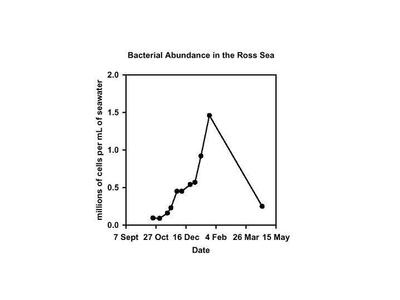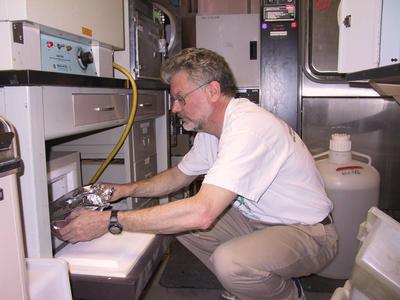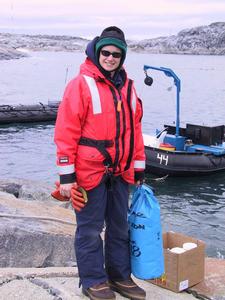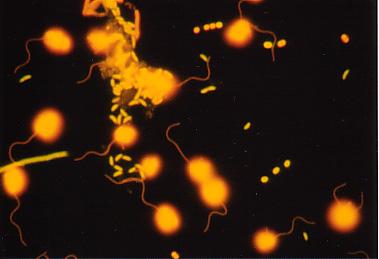21 February, 2002
BRILLIANT BACTERIA !
As with every other place in the world, bacteria can be found
here in the Palmer Station area. In fact, bacteria and other microbes form
a part of the Palmer LTER study. For the first ten years of the LTER, Dave
Karl of the University of Hawaii was the lead scientist of the group
studying the microbiology of this area. Hugh Ducklow of the Virginia
Institute of Marine Science will now be heading the group.
Microbiology is the study of organisms that are less than 150 microns in
diameter. Here is something about size:
A micron is 1/1000 of a millimeter, or 1/1,000,000 of a meter. So, if you
look at a meter stick (about 39 inches), imagine that it is divided into a
million pieces. Each piece is a micron. Or, look at a millimeter, which is
the width of a sharp pencil point. One thousand microns would fit in that
pencil point. The bacteria in the water column here are less than 1 micron
in size. The bacteria in the sea ice are a little larger. They can be 2
microns in size.
Bacteria are an important part of the food web anywhere. In general, the
"job" of bacteria is to recycle energy. Bacteria take up Dissolved Organic
Matter (DOM). This DOM comes from a variety of sources. One source is
from phytoplankton. Some DOM can "spill" out from the phytoplankton cells.
Also, when zooplankton eat phytoplankton, sometimes the cells of the
phytoplankton break. This is called "sloppy eating", and carbon is released
into the water column and dissolves.
Some organisms cannot use DOM. This is where bacteria are so important.
Bacteria change the DOM into Parcticulate Organic Matter (POM). Many other
marine organisms eat this POM. So, bacteria are involved in the uptake and
transfer of carbon in the food chain.
This process occurs in the world's oceans, seas, and lakes. In the
Antarctic Peninsula, the process is somewhat slower than elsewhere. The sea
ice provides a habitat for microorganisms such as bacteria. Bacteria
respond to the seasonal increase in their food---the organic matter from the
phytoplankton bloom. The bacteria accumulate (increase in number). This
happens because they are not preyed upon by some other organism as fast as
they themselves grow.
So, bacteria play a part in the network of the ecosystem. It is important
to study them. As Hugh Ducklow said, he is ". interested in knowing how
many bacteria are here, what they are doing, and how fast they are doing
it."

This graph shows the abundance of bacteria in the Ross Sea. These data come from cruises from 1994 through 1997. It shows what scientists call a "composite year". The Ross Sea is on the other side of the continent from Palmer Station. This graph is courtesy of Hugh Ducklow, who has done his earlier Antarctic work in the Ross Sea.

Hugh Ducklow demonstrates the use of the muffle furnace.

Amy Chiuchiolo is a graduate student working with Hugh Ducklow and Rebecca Dickhut. Amy goes out in a Zodiac to collect water samples. The samples are used in experiments involving bacteria.

Hugh Ducklow in the lab, setting up some materials for a different scientific process.

Here you can see an image of bacteria with some other organisms. The bacteria are the very small dots. Some of them are shaped like a grain of rice. This is not the natural color of the bacteria. They have been "stained", or colored, so that they can be seen under a microscope. Image courtesy of Hugh Ducklow.
Contact the TEA in the field at
.
If you cannot connect through your browser, copy the
TEA's e-mail address in the "To:" line of
your favorite e-mail package.
|
